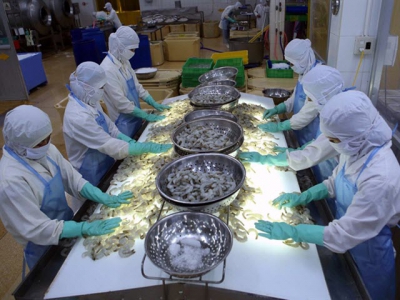Seafood industry needs new strategy to benefit from trade pacts

Ho Chi Minh City — The seafood industry must envision a long-term strategy to make full use of new trade pacts and prepare for problems that might arise when they take effect, Trương Đình Hòe, VASEP general secretary, said.
Shrimp processed at Cửu Long Seafood JSC in Trà Vinh Province's Trà Vinh City. Việt Nam ranks second globally in shrimp exports, with a market share of 14 per cent, only behind India (15 per cent). — VNA/VNS Photo Vũ Sinh
“Two major trade agreements will result in lower tariffs imposed on Vietnamese goods, but domestic enterprises will also face competition with foreign rivals in addition to stringent regulations on product quality and trace of origin,” he said.
Hòe was speaking at a conference in HCM City on Wednesday on the challenges and opportunities faced by the seafood sector under the Comprehensive and Progressive Agreement for Trans-Pacific Partnership (CPTPP), which took effect in January, and the EU-Việt Nam Free Trade Agreement (EVFTA), which is expected to be approved by the EU Parliament late this year or early next year.
The EVFTA, which was signed by Việt Nam in June, will cut tariffs on 99 per cent of goods traded between the two sides. Việt Nam’s agriculture and seafood exports, as well as other industries in which the country has strengths, are expected to see substantial benefits.
Nguyễn Thị Thu Trang, director of the World Trade Organisation (WTO) Integration Centre at the Việt Nam Chamber of Commerce and Industry (VCCI), said that EVFTA and CPTPP would offer fishery firms a chance to expand exports, especially to new markets such as Canada, Peru and Mexico.
Việt Nam ranks second globally in shrimp exports, with a market share of 14 per cent, only behind India (15 per cent).
Challenges
EVFTA is a new-generation FTA that comes with higher standards, and as a result the industry will face strict regulations in terms of the origin of goods, even in textiles and garments, a traditionally strong sector for Việt Nam, experts said.
In addition, labour rules under the trade agreement will be stricter, requiring local businesses to adapt to its requirements.
To take full advantage of the EVFTA, local enterprises must adjust their production to meet standards on quality, origin, labour, and environmental protection, among other issues.
Regulatory bodies and firms also need to be prepared to deal with foreign goods that detour into Việt Nam to take advantage of the CPTPP and other FTAs that the country has signed.
The CPTPP has provisions for investor-state disputes that allow foreign investors to sue the member state.
To prepare for this, Việt Nam needs to comply with all regulations to prevent disputes with foreign investors.
To take advantage of the benefits from the CPTPP, the country will need to build a legal framework to effectively implement the trade pact.
Businesses must also understand the opportunities and challenges that CPTPP offers and ramp up their activities and production, experts said.
The readiness of enterprises is especially critical, they said.
Exporters should also ensure that their products meet requirements on traceability and technical standards, as well as plant and animal safety and hygiene criteria of the EU.
Trần Đình Luân, deputy general director of the Directorate of Fisheries under the Ministry of Agriculture and Rural Development, said the seafood industry was still dealing with the “yellow card” warning from the European Commission despite Việt Nam's efforts to fight illegal, unreported and unregulated (IUU) fishing.
The yellow card warning is given to nations considered at risk of being classified as uncooperative in the fight against IUU fishing, he said.
Exports from yellow-card countries are subjected to intense scrutiny, and since the warning was imposed, all Vietnamese fish exports have been inspected.
Announced in 2017, the yellow card identified shortcomings in Việt Nam’s efforts to fight illegal fishing, Luân said.
This year the seafood industry has set a target of $10 billion worth of exports, a rise of 11.1 per cent over last year.
Việt Nam’s seafood exports to the other 10 members of CPTPP rose by 15 per cent year-on-year to $502 million in the first four months since the agreement took effect, according to the ministry.
Overall exports were $2.5 billion, an increase of 2.4 per cent, the Ministry of Agriculture and Rural Development said.
Related news
Tools

Phối trộn thức ăn chăn nuôi

Pha dung dịch thủy canh

Định mức cho tôm ăn

Phối trộn phân bón NPK

Xác định tỷ lệ tôm sống

Chuyển đổi đơn vị phân bón

Xác định công suất sục khí

Chuyển đổi đơn vị tôm

Tính diện tích nhà kính

Tính thể tích ao



 Low trophic aquaculture in the spotlight in new…
Low trophic aquaculture in the spotlight in new…  Prices of tra fish plunge, breeders suffer huge…
Prices of tra fish plunge, breeders suffer huge…